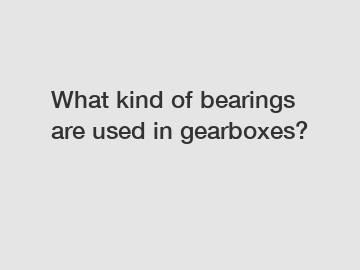What kind of bearings are used in gearboxes?
Gearboxes are the unsung heroes of many industrial applications, ranging from automobiles to wind turbines. These precision machines rely on a complex arrangement of components to transfer power efficiently and reliably. Among these vital components, bearings play a crucial role in facilitating smooth operation and minimizing frictional losses. In this article, we will delve into the fascinating world of gearboxes and explore the various types of bearings that enable their seamless functionality.
Chapter 1: Understanding the Basics of Gearboxes .
Before diving into the specifics of bearings, it's important to grasp the fundamental workings of gearboxes. Often referred to as speed reducers or increasers, they convert input energy to output energy at different speeds and torque values. Gearboxes achieve this by meshing gears of varying sizes and tooth counts. This intricate system requires precise alignment and smooth rotation, which is where bearings step in.

Chapter 2: Rolling Element Bearings.
The most common type of bearing used in gearboxes is the rolling element bearing. These bearings are designed with small metallic spheres or cylindrical rollers that roll between two races. In gearboxes, most rolling element bearings applied include deep groove ball bearings, tapered roller bearings, and cylindrical roller bearings, each featuring unique load-carrying capabilities and contact area arrangements.
Chapter 3: Plain Bearings.
Another bearing type employed to support gearbox mechanisms is the plain bearing. These bearings consist of a low-friction surface, such as a polymer or metal sleeve, that directly interfaces with the rotating shaft. Plain bearings are ideal in situations where there is minimal load and high-speed rotation. They often find use in small gearboxes where compactness and efficiency are key requirements.
Chapter 4: Thrust Bearings.
Gearboxes, particularly those used in heavy-duty applications like marine propulsion systems or large industrial machinery, require additional support to bear axial loads. Thrust bearings excel in such scenarios where forces act parallel to the bearing axis, preventing any axial movement of rotating components. Rolling thrust bearings and hydrodynamic thrust bearings are commonly integrated, with the latter often being oil lubricated in larger systems.
Chapter 5: The Role of Lubrication.
Effective lubrication is critical for the optimal performance and longevity of bearings in gearboxes. Lubricating fluids, such as oil or grease, create a thin film between the rolling elements and races. This film prevents metal-to-metal contact, reducing friction and wear. Furthermore, lubrication dissipates heat generated within the bearing, ensuring the gearbox operates within safe temperature ranges.
Chapter 6: Special Considerations for Gearbox Bearings.
Gearboxes are subjected to different loads, vibrations, and operating conditions. As a result, various design considerations must be accounted for in bearing selection. Factors like misalignment tolerance, load-carrying capacity, operating speed, and temperature are crucial to determine the ideal bearing solution. Advanced technologies and materials, such as ceramic or hybrid bearings, help achieve greater efficiency and longevity in demanding gearbox applications.
Conclusion:
Bearings play an indispensable role in the smooth operation of gearboxes, facilitating efficient power transmission and reducing energy losses within these vital machines. This article has provided an overview of the various types of bearings used in gearboxes, including rolling element bearings, plain bearings, and thrust bearings. Recognizing the importance of lubrication and considering specific design considerations are crucial steps in ensuring optimal performance and extended service life for these essential components.
Gearbox technology continues to evolve, and innovative bearing designs continue to push the boundaries of efficiency and reliability. As industrial applications demand even greater performance, the development of new bearing technologies will undoubtedly shape the future of gearboxes.
Want more information on hub unit bearing mr519923 for mitsubishi outlander front, Audio And Video Equipment Bearing Supplier Manufacturing, Miniature bearings for hobbyist robots and RC cars? Feel free to contact us.
214
0
0

Comments
All Comments (0)